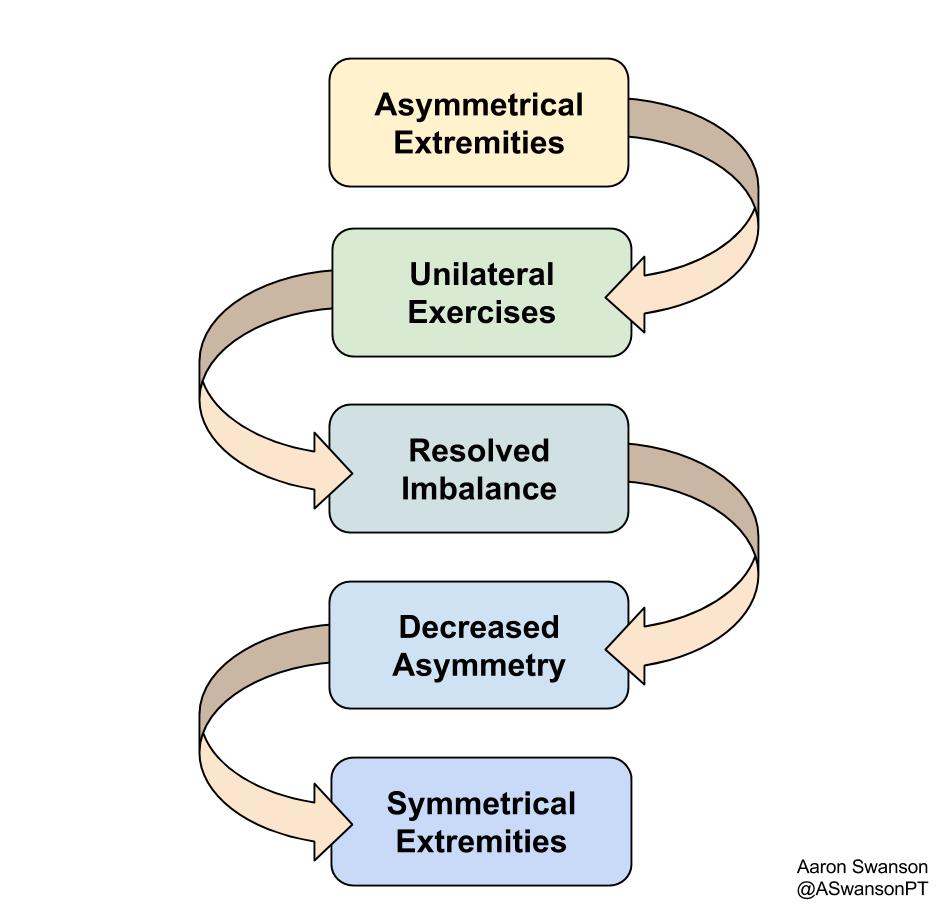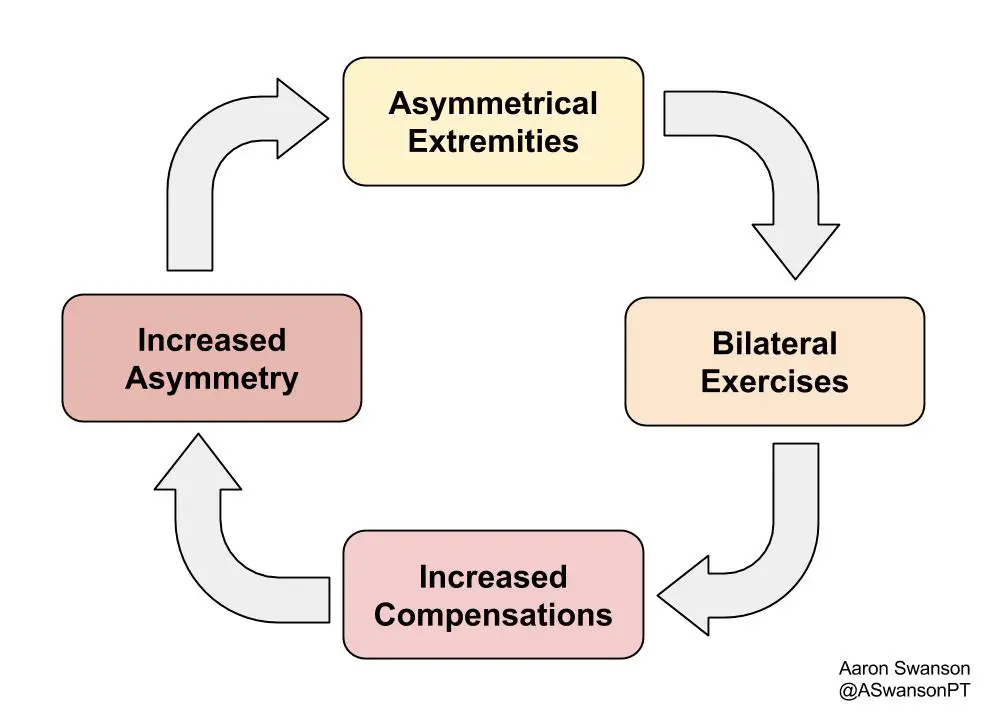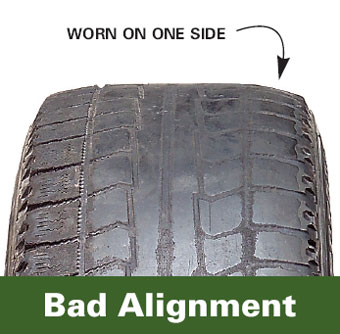Be sure to check out Part I for my thoughts on Crossfit and Mistake #1.
Mistake #2 = Not Training Unilaterally
Our bodies are inherently asymmetrical. Don’t believe me? Here are a couple examples of this natural asymmetry: we have a liver on the right, a heart on the left, 3 lung lobes on the left, 2 on the right, the stomach is tilted, one kidney is higher, the right diaphragm has a better zone of apposition, each brain hemisphere is lateralized for different tasks, and our left-otolitic dominance makes our motor system prefer the right side of our bodies. On top of this, there are many other possible asymmetries and different morphologies due to genetics/ontogenetics.
Not only are our bodies asymmetrical, but we live in a very asymmetrical world. Everyday activities are asymmetrical; you push the car pedals with your right foot, grab your wallet out of the same pocket, open doors with your right hand, use the computer mouse on the same side. Sporting activities are asymmetrical; you shoot with your right hand, kick with your right leg, swing a golf club to the same direction everytime. And then there is just plain handedness.
These asymmetries are normal and usually not a problem. However, sometimes these asymmetries become too significant. The imbalances become too much for the body to handle.
This asymmetrical problem is taken to the next level when you add a symmetrical load to the system. Symmetrically loading an asymmetrical system is the formula for injuries. And this is one of the biggest mistakes Crossfitters make.
While this applies to the entire body, it is critical in shoulders. There are two reasons why:
1) You have a much more prominent handedness than footedness
2) Your legs benefit from some unilateral weight bearing activities everyday (walking, stairs)
Therefore, your upper extremity asymmetry is accelerated much faster compared to the lower extremity. In other words, a right handed person can pretty much go all day without using their left arm at all.
Fast forward to this person going from not using their non-dominant arm for most of their life (or past few years) and then throw a barbell at them. It’s not going to go well. The symmetrical external load (barbell) won’t be met with a symmetrical internal force (muscles). Bringing a symmetrical exercise to an asymmetry is a recipe for disaster.
Look at your car for an analogy. If you car alignment is off, it’s going to cause some big problems. Not only is most of the load going to be dumped onto one side, but it will also prevent a smooth straight path. With the alignment off, the car will naturally want to veer from straight. But it is being driven in a straight path, so the car has to pull (compensate) to maintain the desired direction.
The same thing happens at your shoulders with barbell exercises. One shoulder will get too much of the load, the other has to compensate to keep it straight, and it becomes an internal tug-of-war to keep the all important straight bar path. Therefore, if you have a shoulder asymmetry, then the whole time you are cleaning, pressing, or snatching your shoulders will be compensating against each other.
As mentioned in Part I, over time compensations lead to decreased performance and injuries.
So what do you do about this? Start brushing your teeth with your non-dominant arm? Do barbell cleans with one arm? Walk on your hands?
A Suggestion
The best thing you can do is incorporate some single arm (unilateral) strengthening into your weekly workouts. This will not only prevent injuries, but it can also be used as an assessment. If you can strict press 70# with your right arm, but only 50# with your left, then what do you think is happening when you strict press with a barbell?

Break the vicious cycle by training unilaterally. It will fix your weaknesses, prevent injury, and improve performance.
There are many different ways to work on unilateral strengthening, but in my opinion kettlebells are the best equipment to accomplish this. They allow for the same metabolic burn, similar technique work, multi-joint strengthening, and most importantly – unilateral strengthening. Pavel said it best “Your body has to adapt to the barbell while the kettlebell works with your body.”
Here’s a list of some unilateral shoulder exercises that can be done with just a kettlebell and some space:
Armbars, Bear Crawls, Quadruped T’s, TGU, Single Arm Push Ups, Half/Tall-Kneeling/Standing KB Strict Press, Farmers Walks (overhead, rack, suitcase), Single Arm KB: Swing, Squat, Clean, Clean & Squat, Clean & Strict Press, Clean & Push Press, Snatch, Unilateral Suitcase Deadlift, Plank KB Pull Through
There are plenty of great coaches that can probably come up with some amazing unilateral upper extremity WODs. There’s not just one right way to do it. As long as you are training unilaterally and exposing weakness you will be decreasing your risk of injury and improving performance.
For clinicians there is this Clinical Pearl
- If someone comes in with dominant side shoulder pain from bilateral/symmetrical training, the fix may be to strengthen the non-dominant side
Bottom Line
Like anything that becomes popular or trendy, there quickly becomes a group of people that jump on the bandwagon and a group of people that protest against it. But this isn’t EDM, this isn’t Instagram, this isn’t the new iPhone. This is simply another opportunity to help people stay active and exercise. It’s not for everyone, but it’s not for no one.
Medical professionals need to focus on ways to reduce injury and improve the activity rather than just pointing out what we don’t like. Crossfit coaches need to focus on what’s best for the athletes health rather than what will give them the best workout. And the Crossfit athletes need to be educated on the risk of lifting with poor technique and/or with a significant asymmetry.
References
Strength is a Good Thing
1) Preethi Srikanthan, Arun S. Karlamangla. “Muscle Mass Index as a Predictor of Longevity in Older-Adults.” The American Journal of Medicine (2014)
2) Lauersen JB, Bertelsen DM, Andersen LB. The effectiveness of exercise interventions to prevent sports injuries: a systematic reviewand meta-analysis of randomised controlled trials. Br J Sports Med. (2014) Jun;48(11):871-7.
3) Harridge, Stephen D.r., Ann Kryger, and Anders Stensgaard. “Knee Extensor Strength, Activation, and Size in Very Elderly People following Strength Training.” Muscle & Nerve 22.7 (1999): 831-39.
4) Suetta, C., S. P. Magnusson, N. Beyer, and M. Kjaer. “Effect of Strength Training on Muscle Function in Elderly Hospitalized Patients.”Scandinavian Journal of Medicine & Science in Sports 17.5 (2007)
5) Askling, C., J. Karlsson, and A. Thorstensson. “Hamstring Injury Occurrence in Elite Soccer Players after Preseason Strength Training with Eccentric Overload.” Scandinavian Journal of Medicine and Science in Sports 13.4 (2003): 244-50
6) Nadler, Scott F., Gerard A. Malanga, Melissa Deprince, Todd P. Stitik, and Joseph H. Feinberg. “The Relationship Between Lower Extremity Injury, Low Back Pain, and Hip Muscle Strength in Male and Female Collegiate Athletes.” Clinical Journal of Sport Medicine 10.2 (2000): 89-97.
7) Peate, Wf, Gerry Bates, Karen Lunda, Smitha Francis, and Kristen Bellamy. “Core Strength: A New Model for Injury Prediction and Prevention.”Journal of Occupational Medicine and Toxicology 2.1 (2007)
8) Orchard, J., J. Marsden, S. Lord, and D. Garlick. “Preseason Hamstring Muscle Weakness Associated with Hamstring Muscle Injury in Australian Footballers.” The American Journal of Sports Medicine25.1 (1997): 81-85
9) Jankowski, C.m. “The Effects of Isolated Hip Abductor and External Rotator Muscle Strengthening on Pain, Health Status, and Hip Strength in Females With Patellofemoral Pain: A Randomized Controlled Trial.”Yearbook of Sports Medicine 2012 (2012): 65-66.
10) Willson JD, Dougherty CP, Ireland ML, et al. “Core stability and its relationship to lower extremity function and injury. J Am Acad Orthop Surg. (2005) Sep;13(5):316-25.
11) Hewett TE, Lindenfeld TN, Riccobene JV, et al. “The effect of neuromuscular training on the incidence of knee injury in female athletes. A prospective study.” Am J Sports Med. (1999) Nov-Dec;27(6):699-706.
Movement Based Exercise vs. Isolated Exercise
12) Gentil, Paulo, Saulo Rodrigo Sampaio Soares, Maria Claúdia Pereira, et al. “Effect of Adding Single-joint Exercises to a Multi-joint Exercise Resistance-training Program on Strength and Hypertrophy in Untrained Subjects.” Applied Physiology, Nutrition, and Metabolism 38.3 (2013): 341-44
13) Gottschall, Jinger S., Jackie Mills, and Bryce Hastings. “Integration Core Exercises Elicit Greater Muscle Activation Than Isolation Exercises.”Journal of Strength and Conditioning Research 27.3 (2013): 590-96
Exercising in Fatigued State
14) Cortes, Nelson, Eric Greska, Roger Kollock, Jatin Ambegaonkar, and James A. Onate. “Changes in Lower Extremity Biomechanics Due to a Short-Term Fatigue Protocol.” Journal of Athletic Training 48.3 (2013): 306-13.
15) Santamaria, Luke J., and Kate E. Webster. “The Effect of Fatigue on Lower-Limb Biomechanics During Single-Limb Landings: A Systematic Review.” Journal of Orthopaedic & Sports Physical Therapy 40.8 (2010): 464-73.
16) Barnett S Frank, Christine M Gilsdorf, Benjamin M Goerger, et al. “Neuromuscular fatigue alters postural control and sagittal plane hip biomechanics in active females with anterior cruciate ligament reconstruction.” Sports Health (2014) Jul;6(4):301-8
17) Quammen D, Cortes N, Van Lunen BL, et al. “Two different fatigue protocols and lower extremity motion patterns during a stop-jump task.” J Athl Train. (2012) Jan-Feb;47(1):32-41.
18) Pau M, Ibba G, Attene G. “Fatigue-induced balance impairment in young soccer players.” J Athl Train. (2014) Jul-Aug;49(4):454-61.
Imbalances Are Bad
19) Knapik, J. J., C. L. Bauman, B. H. Jones, J. Mca. Harris, and L. Vaughan. “Preseason Strength and Flexibility Imbalances Associated with Athletic Injuries in Female Collegiate Athletes.” The American Journal of Sports Medicine 19.1 (1991): 76-81
20) Baumhauer, J. F., D. M. Alosa, P. A. F. H. Renstrom, S. Trevino, and B. Beynnon. “A Prospective Study of Ankle Injury Risk Factors.” The American Journal of Sports Medicine 23.5 (1995): 564-70.
21) Common Sense & Conventional Wisdom (>6 million years BC)
Motor Learning
22) Cook, Gray. Movement: Functional Movement Systems: Screening, Assessment, and Corrective Strategies. Aptos, CA: On Target Publications, 2010. Print.
23) Schmidt, Richard A., and Craig A. Wrisberg. Motor Learning and Performance: A Problem-based Learning Approach. Champaign,IL: Human Kinetics, 2004.
24) Williams, L. R., McEwan, E. A., Watkins, C. D., Gillespie, L., & Boyd, H. (1979). Motor learning and performance and physical fatigue and the specificity principle. Canadian Journal of Applied Sport Sciences, 4, 302-308.
“The body does not have the capacity to learn movement patterns when highly stressed/fatigued. This factor is not related to the specificity of training principle associated with overload adaptation in energy systems. The specificity principle of physiological adaptation does not apply to motor learning. To learn skilled movement patterns that are to be executed under fatigued conditions, that learning has to occur in non-fatigued states” — Williams 1979
—
The main reason I do this blog is to share knowledge and to help people become better clinicians/coaches. I want our profession to grow and for our patients to have better outcomes. Regardless of your specific title (PT, Chiro, Trainer, Coach, etc.), we all have the same goal of trying to empower people to fix their problems through movement. I hope the content of this website helps you in doing so.
If you enjoyed it and found it helpful, please share it with your peers. And if you are feeling generous, please make a donation to help me run this website. Any amount you can afford is greatly appreciated.




